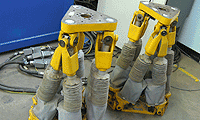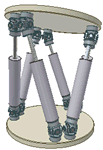



| home |
| about the meeting |
| main speakers and courses |
| talks/posters |
| registration form |
| study group |
| organizers |
| travel & accomodations |
| participants |
| poster |
| timetable |
| contacts |
| documentation |
| impact |

Posters
- Teaching
Probability and Statistis in Civil Engineering - an interdisciplinary
challenge (Noémia Simões ISEL – DEC
nsimoes@dec.isel.ipl.pt)
Abstract: Teaching probability and statistics in
civil engineering is an interdisciplinary challenge. In this poster
we'll first try to show with practical examples collected from tests
and exames, how engineering and science (probability ans statistics)
need each other. We finally present a critical view on the actual
discipline program, defending that Bayesian statistics is a more
adequate framework that allows to integrate tacit knowledge in
probability evaluation and decision making in the context of civil
engineering.
- NLP in Java Technology
(Aldina Correia, Instituto
Politécnico do Porto (ESTGF), aic@estgf.ipp.pt)
Abstract: In this work we present a
synopsis of the most popular methods to solve Constrained and
Unconstrained Nonlinear Problems, without using derivatives or
approximations of them.
We briefly present the general structure of our future Web Application, that will be able of solving those problems. Then we describe summary some results that were achieved through the implementation that has been made in Java Technology.
We briefly present the general structure of our future Web Application, that will be able of solving those problems. Then we describe summary some results that were achieved through the implementation that has been made in Java Technology.
- Evolution of energy indicators in Portugal: the STATIS
methodology (Adelaide M.
S. Figueiredo, Faculdade de Economia da Universidade do Porto /
LIAAD-INESC Porto, adelaide@fep.up.pt)
Abstract: In this study we apply the STATIS
methodology (Structuration des Tableaux à Trois Indices de la
Statistique) developed by Lavit (1988) and Lavit et al (1994) to
analyse the evolution of some energy indicators in the NUTS II regions
of Portugal between 2004 and 2006.
Keywords: Energy indicators; Principal Component Analysis; STATIS methodology
References
Lavit, C. (1988). Analyse conjointe de tableaux quantitatifs. Éditions Masson.
Lavit, C.; Escoufier, Y.; Sabatier, R. and Traissac, P. (1994). The ACT (Statis method). Computational Statistics and Data Analysis, vol. 18, p.97-119.
Keywords: Energy indicators; Principal Component Analysis; STATIS methodology
References
Lavit, C. (1988). Analyse conjointe de tableaux quantitatifs. Éditions Masson.
Lavit, C.; Escoufier, Y.; Sabatier, R. and Traissac, P. (1994). The ACT (Statis method). Computational Statistics and Data Analysis, vol. 18, p.97-119.
- The Minimization of Open Stacks Problem (Isabel Cristina Lopes, ESEIG -
Politecnico do Porto, cristinalopes@eu.ipp.pt)
Abstract: The problem we present here arises in
several contexts, such as the cutting industry (steel tubes, paper,
flat glass, wooden panels,…), task planning, and even in VLSI (Very
Large Scale Integration) circuit design.
In the context of the cutting industries, the different items obtained from the cutting patterns are usually piled separately near the machine in which they were cut, creating several open stacks of items of the same size. Each of these stacks is removed from the work area and taken to the warehouse only after all items of that size have been cut. Due to space limitations and transportation costs, it is desirable to maintain near the machine only the least number of open stacks as possible. This optimization is done by finding a sequence of the cutting patterns that minimizes the number of open stacks during the process.
In this poster we will present this NP-hard problem, known in the literature as MOSP, and view an historical perspective of the different methods used by several authors for addressing this problem, such as branch-and-bound techniques, heuristics, integer programming and graph theory.
In the context of the cutting industries, the different items obtained from the cutting patterns are usually piled separately near the machine in which they were cut, creating several open stacks of items of the same size. Each of these stacks is removed from the work area and taken to the warehouse only after all items of that size have been cut. Due to space limitations and transportation costs, it is desirable to maintain near the machine only the least number of open stacks as possible. This optimization is done by finding a sequence of the cutting patterns that minimizes the number of open stacks during the process.
In this poster we will present this NP-hard problem, known in the literature as MOSP, and view an historical perspective of the different methods used by several authors for addressing this problem, such as branch-and-bound techniques, heuristics, integer programming and graph theory.